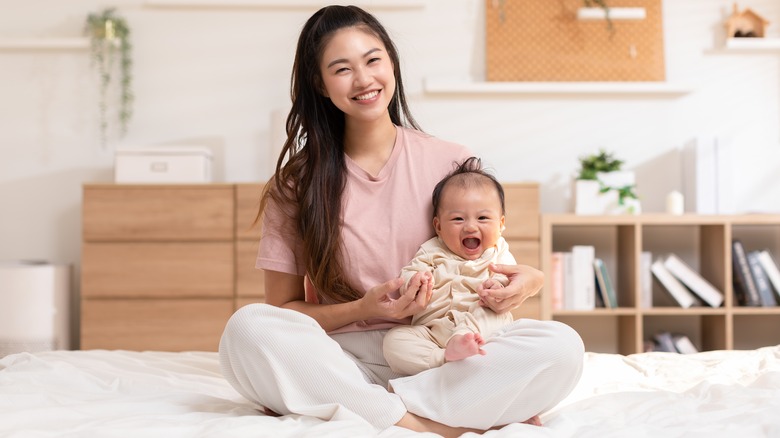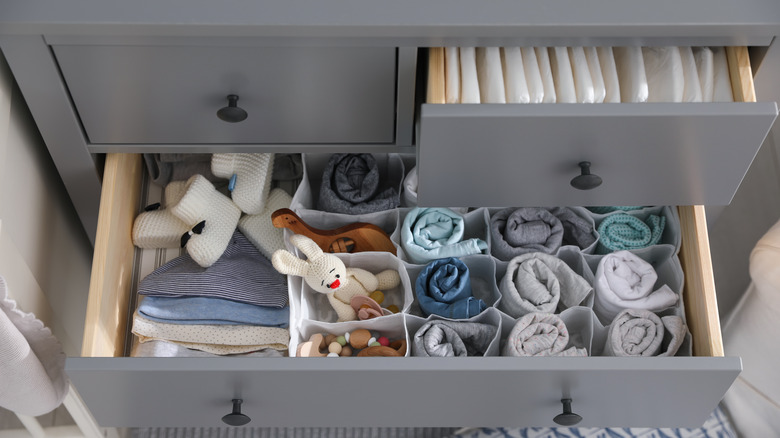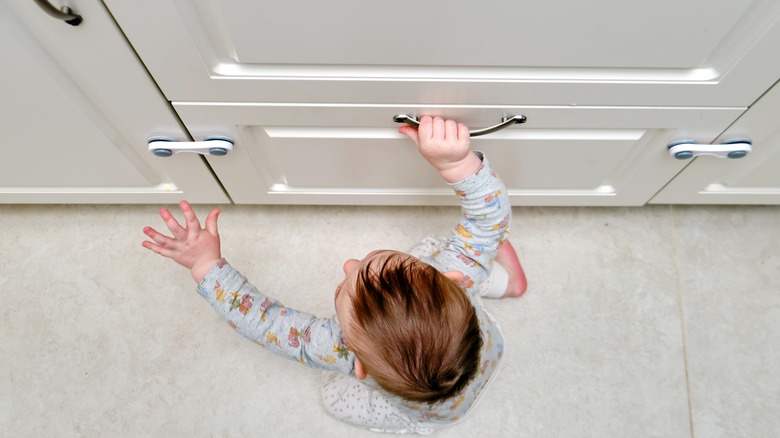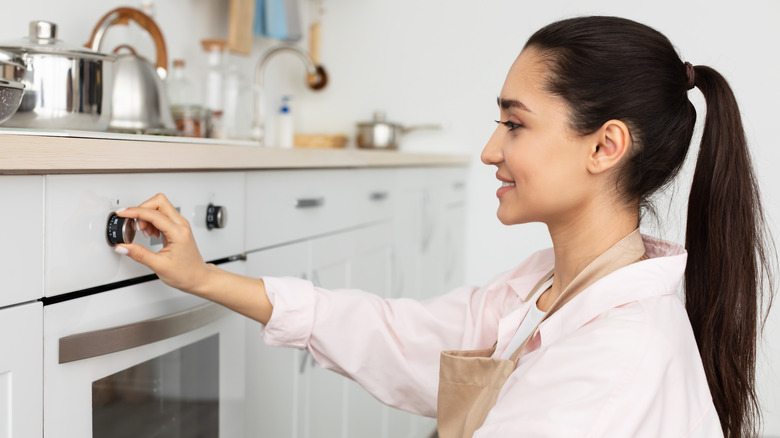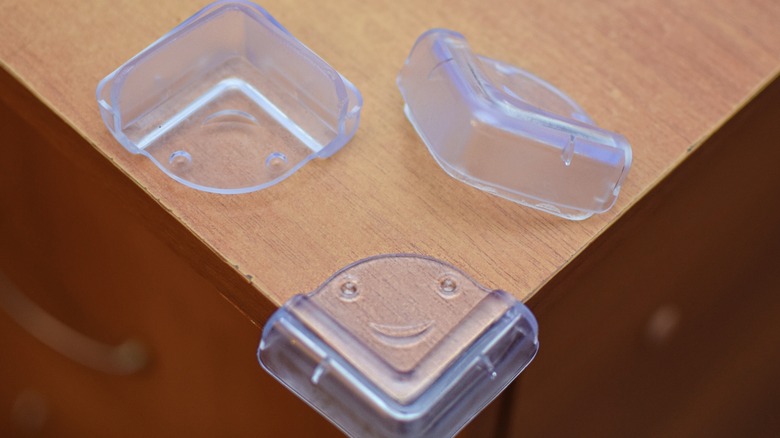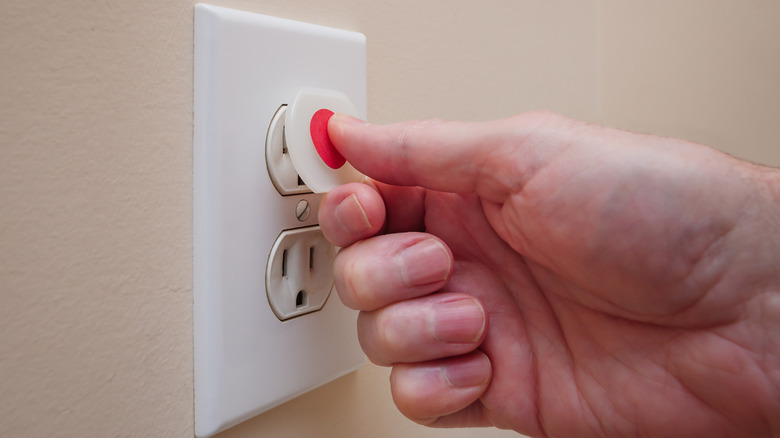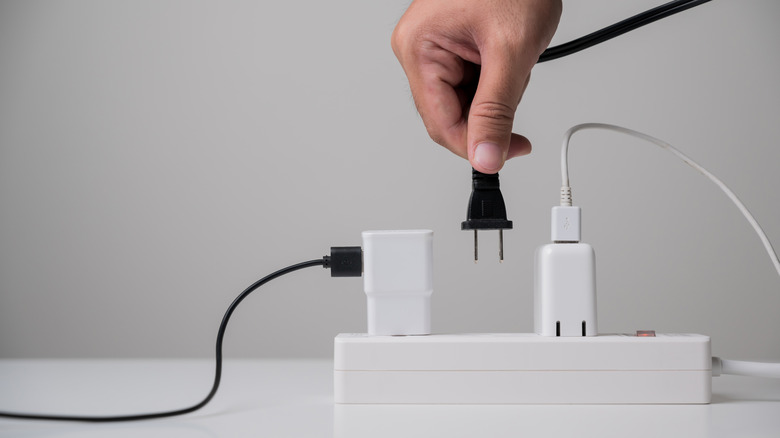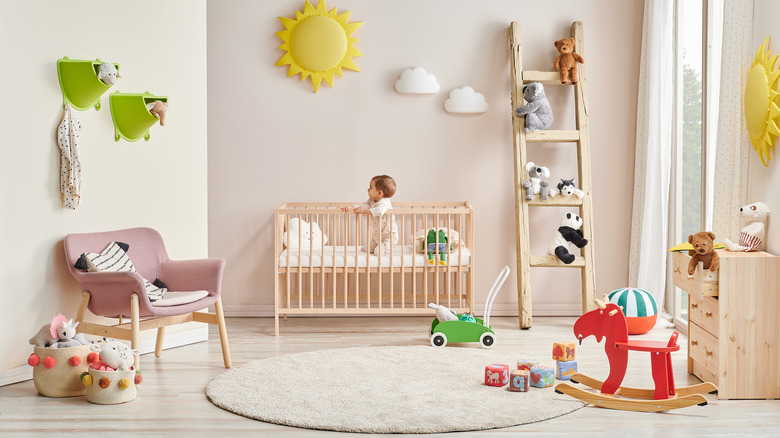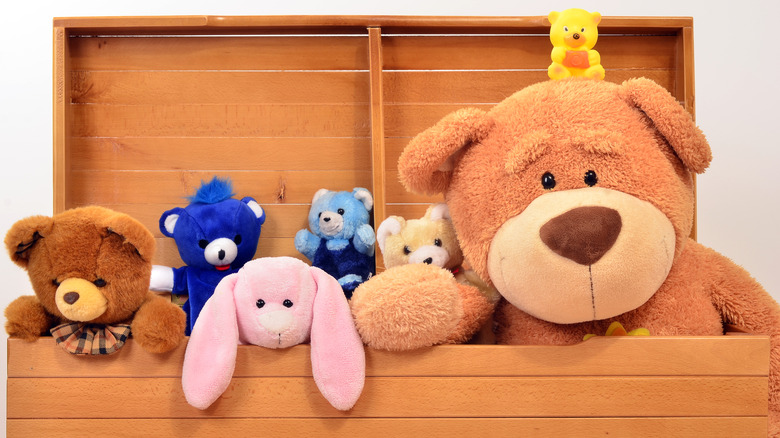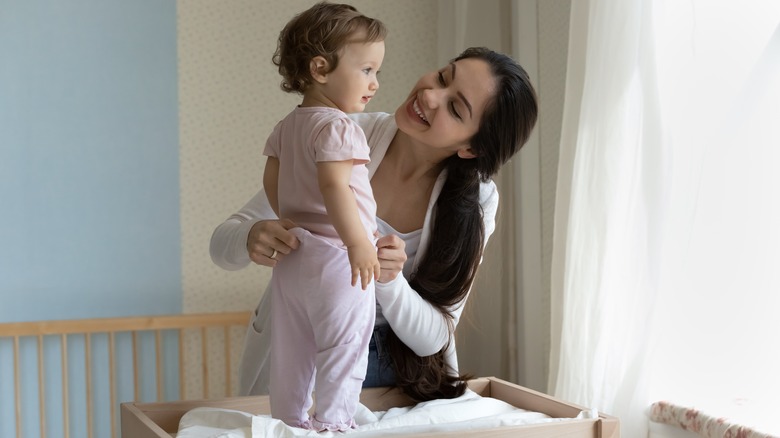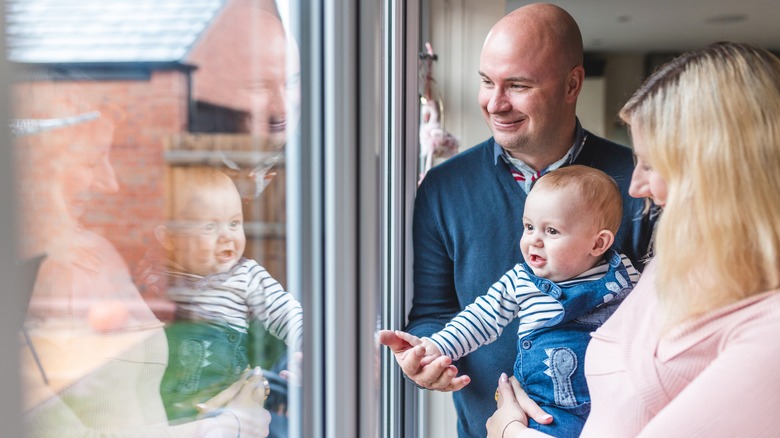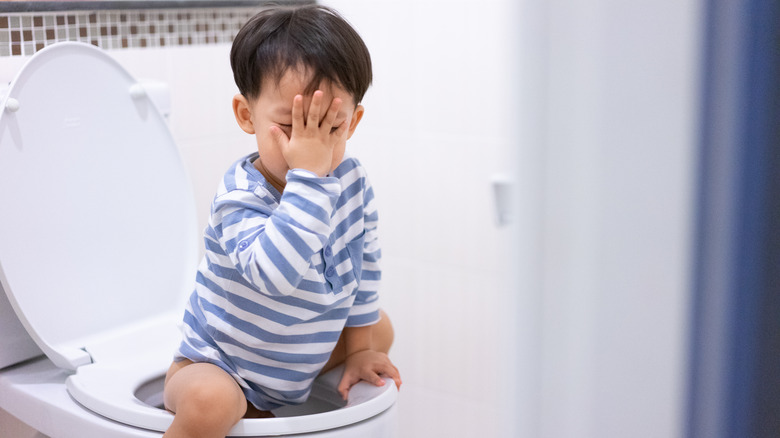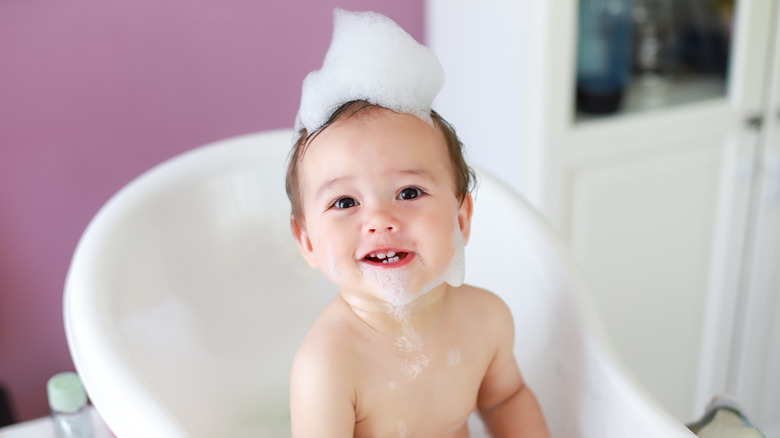Tips On Baby Proofing The Home
We may receive a commission on purchases made from links.
Every parent wants to keep their children safe. With the rise of accidental deaths and injuries in the home, it's important to keep home renovations in check, per On The Pulse. Before completing any major home renovations, check for noxious substances. Some homeowners have geared up with air humidity detection meters to keep track of mold spreading throughout the home. Old paint tends to be prevalent in older homes, so check for lead to prevent harmful chemicals from hurting the family. In addition, you should get rid of broken light bulbs because mercury from the bulb could leak and spread around the home.
Safety in the home should be a top priority for parents with babies. Keep a close eye on younger children around the baby to ensure there's no rough play involved (via Better Health Channel). Watch your pets so that they don't startle the baby. Keep items like hot drinks or sharp objects out of reach. While it's impossible for parents to watch their baby every waking moment of the day, you can follow these simple tips to baby-proof your home and make it as safe as possible.
Mount heavy furniture
Heavy furniture in the home should always be secured and mounted, per Childproofing Experts. Even if the furniture is heavy and hard to move, babies can still try to climb on top of open drawers. Some parents may assume they don't need to anchor furniture because their babies don't go into the room, like the primary bedroom. Babies can still wander into a room unsupervised, so anchor all furniture properly. Just because you latch drawers shut doesn't mean the furniture will stay as is. While older children have the common sense to not climb on top of items, they may forget their own safety when they need to get something. Safety has nothing to do with how expensive the furniture is. Whether secondhand or new, furniture that's not anchored can seriously injure a baby.
A couple of tips on anchoring heavy furniture is to use actual furniture anchors. Don't use plastic ties because they wear down over time (via Childproofing Experts). Heavy furniture may require at least two restraints per piece. The top part of the restraint anchors to the base, which then anchors to the wall. The anchor should be attached to a wall stud, and the restraints should be tight. Find the wall stud by using a level. Parents can hire a professional to ensure that their furniture is secure.
Purchase cabinet locks
While cabinets are excellent places to store household items, they can pose a hazard to babies, especially when they contain sharp objects such as knives, per Stay Safe. Not only can cabinets hold dangerous items that are inappropriate for babies to handle, but infants can also get injured if cabinet doors hit their fingers. Parents should invest in locks that'll prevent serious injuries from occurring.
Four main locks work for cabinets that can be used in everyday life (via The Cabinet Center). For a no-fuss way to keep cabinets locked and prevent babies from prying, try magnetic locks. Magnetic locks require a piece of hardware mounted inside the cabinet. The cabinet is activated to open when you hold a key against it. Adhesive cabinet locks have an adjustable strap that connects two cabinet knobs beside each other. With corded cabinet locks, a cord wraps around two cabinet knobs. Pull one of the strings on the cord to seal the loop tightly. Another cabinet lock example is spring release locks. They hook onto the inside of the cabinet door, and it's easy to press down on the hook to open the door. If you need new cabinet locks, the 10 Pieces Sliding Cabinet Locks on Amazon are child-proof and easy to install.
Put covers on stove knobs
Parents need to practice safety in the kitchen with their babies. The first rule of thumb is to avoid carrying hot food and drinks while holding a baby. Keep hot meals pushed away from the edge of dinner tables and countertops. Turn handles on pots and pans to the back so your baby can't reach up and try to grab the food. Stoves should never be left unattended. If the baby is in the kitchen with their parents cooking, they should not have access to any hot surfaces. While most families prefer to warm food up in the microwave or oven, parents should also test their baby's food to ensure it isn't too hot for them to eat.
Young children turning oven and stove knobs on can lead to burns and gas leaks (via Dreambabytv on YouTube). Try purchasing plastic covers that fit securely over the stove knobs. Parents press the opening tag on these plastic covers to access the knob. To close, shut the cover to click in place. Hearing the clicks allows the parent to know the knobs are locked securely.
Place hard cover pads on furniture
Since babies are naturally curious, they may want to touch furniture and try to pull themselves up when learning to stand and walk. While it's great when babies learn to be more independent, sharp-cornered furniture can pose a threat. Look for foam piping to place over furniture covers, as suggested by Dave Wirth on YouTube. Some parents cut foam pool noodles in half, but you can also find foam piping at local hardware stores. Foam piping typically has tape on either side and is split in half to fit evenly on furniture edges. The Frost King 0.5-in x 6-ft Foam Tubular Pipe Insulation for 1-in Pipe from Lowe's is an example of foam piping.
Another example of furniture padding is the Delp Baby Safety Table Corner Guard (Set of 12) from Wayfair. Since this product comes in a pack of 12, you can use it for more than one piece of furniture. On the market, silicone furniture guards are also popular for the home to prevent babies and young children from hitting themselves against hard corners. Since most of these silicone guards are clear, they don't look obvious and call attention. Parents should try to purchase furniture that doesn't have hard edges and seek out rounded tables, chairs, and dressers. They will look stylish and keep babies safe.
Use outlet covers for electric sockets
Parents need to be aware of babies near electrical outlets. Since some electric outlets are close to the ground on walls, babies could put their fingers in the outlet holes or stick something inside, as said by Jaffe Electric Company. Parents should focus on electrical outlets that don't have anything plugged in to keep them covered. A straightforward way to cover electric outlets is to purchase plastic covers to go inside the outlet. Ensure the plastic covers are placed securely in the outlets to prevent them from coming loose and posing a choking hazard.
Another outlet protector to consider is swivel outlet covers. Remove the original electric outlet cover before screwing in the new swivel outlet cover. The design prevents babies and young children from pushing their fingers through the outlet holes by acting as a barrier. Sliding door outlet covers are utilized by first screwing on the base and adaptor onto the electric outlet. A base plate is put on top and snapped into place, covering the whole outlet. Be careful using swivel outlet covers and sliding door outlet covers because they can overheat and cause fires. Look for these Mommy's Helper Outlet Plugs on Amazon for plastic electric outlet covers.
Hide electrical wires
Since babies are learning to be more tactile and putting things in their mouths, it's possible that they may try to chew on home electrical wires. Keep electrical wires away from babies by placing them out of sight. According to The Gold Hive, one way to hide electrical wires in the living room is to snake them through an open bookshelf. Find a wicker basket with openings to slide the electrical wires through. You can connect these electrical cords to an extension cord inside the basket that contains multiple outlets.
Cover electrical cords with wall cord hiders (via Echogear on YouTube). The first step is to measure the wall to see how much material is needed. Once everything is measured, use a hand saw to cut as many sections as you need from the cord hider material. The opening of the cord hiders holds the electrical wires in place when parted open. Attach the hiders to the walls if necessary. After installation, cap off and cover any sections that reveal visible wire. Need something for all those wires around the home? This TV Cord Hider from Amazon will effectively keep wires out of sight.
Arrange cushioned non-slip rugs around the home
Having cushioned rugs around the home, and especially in the baby's nursery, will prevent major injuries due to falls. Soft area rugs can break falls and protect the floor from unexpected messes, per ReallyCheapFloors. Parents can add area rugs in the nursery to tie the room design together. Once the child is older, they can decide how to style their room. High-quality rugs are inexpensive and can be easily changed.
Baby nurseries should be comfortable, safe, and devoid of hard floors and sharp edges (via Koeckritz Rugs). Keeping a pad underneath an area rug provides more cushioning in the event of sudden falls. It may be best to keep an area rug near the crib if the baby tries to escape by climbing over the sides. Purchase rugs that are easy to wash and don't hold stains. You can place cushioned non-slip rugs in bathrooms, living rooms, entryways, and foyers. This Beglad Soft Fluffy Area Rug from Amazon is cozy and soft. The rug will fit in with most living room designs. As always, supervise babies while they crawl and walk around the home.
Ensure toy boxes are safe
While babies should play with age-appropriate toys to foster their love of learning and imagination, the Consumer Product Safety Commission notes that toy boxes can pose a threat. Some toy boxes can latch shut automatically and lock the baby inside without the parent knowing. Babies can also die of suffocation if locked inside their toy boxes. Older toy box models have lids that close automatically and can injure a baby on the head or the neck.
While some parents like passing down toy boxes as heirlooms or checking out secondhand stores, it's best to shop for a modern toy box that meets basic safety requirements. This Harmony 32" Toy Chest from Wayfair has safety lid supports and a safety hinge on the lid to prevent finger and hand injuries. If you purchase older models of toy boxes, remove the automatic latches and locks before handing them down to their children. Try to find toy storage bins with removable lids (via HealthyChildren). Add padding to toy boxes with sharp corners, or buy toy boxes with rounded structures.
Find a suitable changing table
Changing tables should have features that adapt with the baby as they grow and become older. According to Kids Health, there are three kinds of changing tables on the market: wooden models with guardrails, fold-up models, and hinged chest adaptors. Parents should look for changing tables with a flat surface and four guard-railed sides. The middle of the table should be lower to prevent the baby from rolling over. While fold-up changing tables are trendy, they need to be dually checked for sturdiness so as not to collapse. Parents should find changing tables with storage shelves and compartments to easily access diaper-changing supplies.
One benefit to changing tables is that there's no need to kneel or squat, which lessens back and leg pains (via Mom Bloggers Club). When shopping around for changing tables, it helps to find something height adjustable to alleviate back pain. Find portable changing tables at local bedding and home stores. A portable table will come in handy if home renovations are happening or once the baby is older and won't need a changing table any longer. The Modern Baby Changing Table with Laundry Hamper from Amazon is a good option if you want a changing table with shelves and compartments.
Install window locks
Prevent falls and serious injuries by keeping babies away from open windows in the home. Any broken window locks should be replaced and repaired, per Window World. Parents should keep furniture away from windows because babies can climb on top and push windows open. You can keep blind cords away from babies by either attaching them to a wall out of reach or completely removing them.
While they may not look aesthetically pleasing, installing window guard bars is another way to prevent babies from hurting themselves on or through windows. Stick padding around windowsills to cover hard edges and soften falls. To prevent babies from trying to open windows, unscrew cranks from window handles and keep them away from babies. You can always reattach them later. Parents can make it a rule to play at least two feet away from windows (via Seattle Children's Hospital). If parents visit a home that's not childproofed, they can try to ensure the windows are closed and locked while keeping a close eye on their child. This Sliding Door Lock on Amazon will work nicely at home.
Add locks to toilets
Training a baby to use the toilet is a significant milestone for many parents. What about safety when babies are near toilets in the bathroom? Childproofing Experts said it's still possible for babies to fall and drown in the toilet. Even in a few inches of water, the baby can get its head stuck inside and not be able to come out. Babies can also catch a bacterial infection if they put their hands in toilet water.
Bathroom cleaners are also dangerous for babies due to the harsh chemicals that make up the solutions. Parents should keep these products in closets away from babies when not in use. If the baby has opened a bottle of cleaner, parents should go to a poison control center to ensure their baby hasn't swallowed anything harmful. Keep all bathroom doors closed in the home and buy locks to prevent babies from wandering inside bathrooms. If you need toilet locks, you can find some from websites like Amazon.
Practice bathtub safety
Bath time is fun for parents and babies but can become a nightmare if you ignore safety. Never leave your baby unattended with soap, towels, and toys within reach, per Mommybites. Parents should give full attention to their baby's bathing routine by not worrying about answering the phone or door. During bath time, use baby-specific soap and shampoo brands instead of adult soaps and shampoos because they tend to be too harsh. Adult soaps and shampoos can dry out a baby's sensitive skin and cause irritation leading to urinary tract infections. A soft bathtub cover will prevent bruises if the baby accidentally bangs themselves against the faucet.
Keep curlers and hairdryers away from the bathtub to prevent electric shock (via Intermountain Healthcare). Don't treat bathtub seats and bath rings like life preservers. Parents also need to be mindful of bathtub water temperatures. Anything too hot can scald the baby's skin. Parents can test the water on their wrists or elbow to ensure it's a safe temperature. Don't forget about non-slip bathmats such as the Non-Slip Shower Mat from Walmart. These mats have suction cups on the bottom that help them stay in place. For parents with babies, it's essential to safety-proof the home by following these tips and guidelines.
